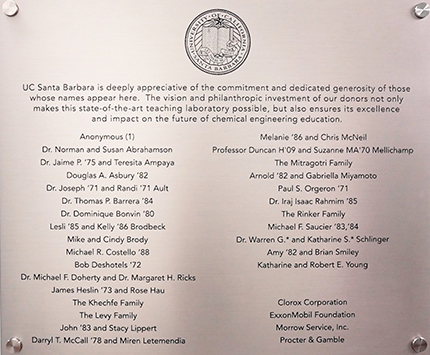A decade-long effort to modernize the UC Santa Barbara Chemical Engineering Department’s undergraduate laboratory facilities culminated with a virtual celebration on October 14. Scores of alumni and department supporters participated in a virtual dedication of the Robert G. Rinker Chemical Engineering Teaching Laboratory, made possible by the completion of a $1 million endowment fund named after Rinker, the first chemical engineering faculty member hired by UCSB.
“I am truly humbled and honored to have my name attached to this generous gift and to the education of our future chemical engineers,” said Rinker, a professor emeritus of the department, during the virtual event. “Thank you to all of the alumni who have contributed to the endowment for their generosity, foresight and persistence in creating this $1 million endowment for the UCSB undergraduate teaching laboratory. The undergraduate lab must evolve as our discipline evolves and that takes funding.”
The endowment, which was overseen by the university’s Office of Development for Engineering, directly impacts the educational experience of the department’s undergraduate students. As a result, the department will be able to design and construct lab experiments that reinforce fundamental chemical engineering principles, expose students to industrially-relevant lab situations, provide practical training on modern, automated equipment, and create a functional, adaptable, and hands-on learning environment that will evolve with the chemical engineering field.
“There are several things that make the Rinker Lab special, but with the endowment the lab becomes even more special,” said Rachel Segalman, chair of the Chemical Engineering Department and the Edward Noble Kramer Professor. “We’re one of the only campuses that now has a dedicated ability to modernize the lab, to look at it through new developments of the world, new problems in the world and think about what laboratory experience are students really going to need to address them.”
The existence of the endowment creates an opportunity for new Assistant Teaching Professor Joseph Chada to build a unique and continuously modernizing lab experience to ensure students receive the hands-on learning experience they need to succeed. Already, the lab has been updated to a pilot- and skid-themed experience.
“This model of gift endowments to support critical teaching lab facilities is extremely important, especially during these times when state funding is uncertain. I would like to thank you for helping us reaching this $1 million level. You’ve made it possible to ensure our undergraduate students will receive the hands-on experience they need to prepare for industry or graduate school,” said Rod Alferness, dean of UCSB’s College of Engineering and the Richard A. Auhll Professor, as he welcomed guests to the event. “This achievement also presents an opportunity to recognize and thank Professor Rinker for the enormous impact he has had on generation after generation of chemical engineering students.”
After starting at California Institute of Technology in 1959, Rinker joined UCSB in 1965 as the university’s first chemical engineering faculty member. The department officially began in 1966 with two faculty members, Rinker and his first hire, John E. Myers, and six undergraduate students. Together, the two “founders” recruited an entire faculty, developed undergraduate and graduate curricula, established the master’s and PhD programs, and designed and built laboratories, laying a foundation for what the department has become today, one of the top ranked programs in the nation. Rinker, who taught the department’s first undergraduate course, became widely known for his early catalyst and chemical reactor research. He went on to serve as the College of Engineering’s Associate Dean for Undergraduate Programs, and was a principal investigator for the university’s Mathematics Engineering Science Achievement (MESA) program that serves educationally disadvantaged students. He retired from UCSB in 2005, after 39 years of service.
“I have always believed that it is critical for our undergraduate students to experience and learn not only the fundamentals of chemical engineering, but also to experience and learn about many of the exciting new frontiers that chemical engineers in both academia and industry are increasingly expected to understand,” said Rinker, who mentioned the department started in the basement of the Arts Building. “This evolution reflects the positive changes and progression of the chemical engineering discipline and the technical advances. This generous endowment will ensure that the UCSB chemical engineering teaching lab will be state of the art and provide our future students with the opportunity to get the best education possible and further the strong reputation of this department into the future.”
The event included a video tour to give guests a glimpse at the updated laboratory. They also unveiled a commemorative plaque outside of the facility that reads, “UC Santa Barbara is deeply appreciative of the commitment and dedicated generosity of those whose names appear here. The vision and philanthropic investment of our donors not only makes this state-of-the-art teaching laboratory possible, but also ensures its excellence and impact on the future of chemical engineering education.” The plaque also listed four companies and nearly forty individual donors and families, more than half of whom are alumni, who contributed to the endowment. In total, more than one hundred faculty, alumni, students, and staff during the campaign that was started in 2006 by Michael Doherty, the current Mellichamp Endowed Chair in Systems Engineering, who was department chair at the time.
The creative solution has inspired other departments to launch similar campaigns. The Electrical and Computer Engineering Department has established a fund for the Dr. John Skalnik Communications Lab. Skalnik, the second dean of the College of Engineering, modified the Department of Electrical Engineering into the ECE Department in 1972.



The modernization and upgrades to the undergraduate teaching facility were made possible by completion of a $1 million endowment.
